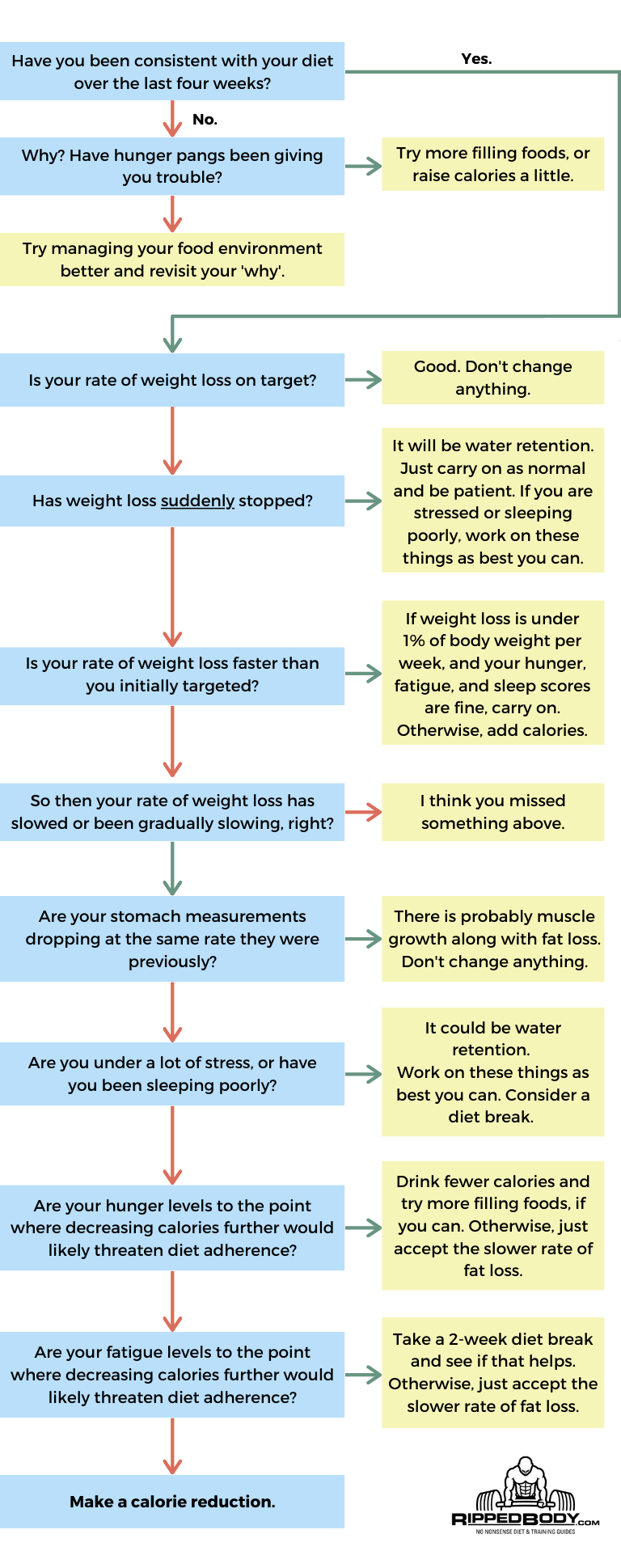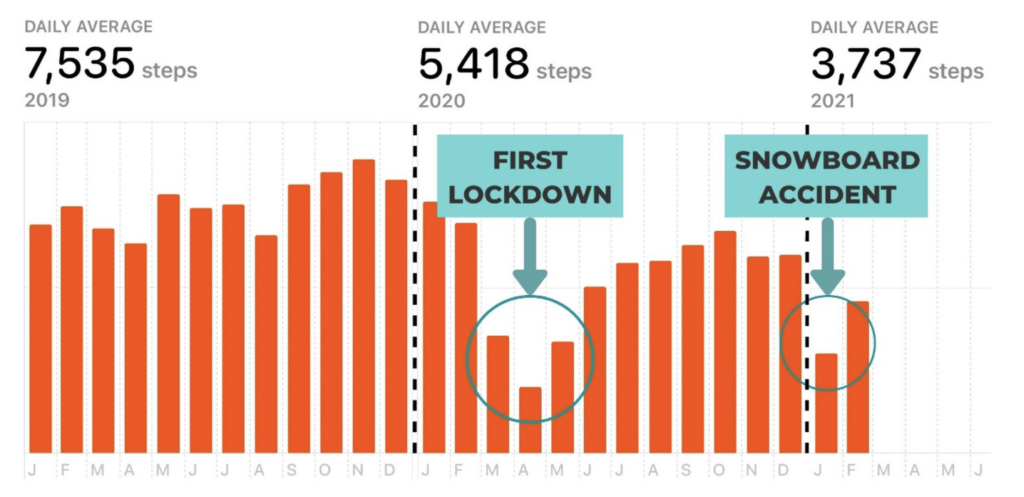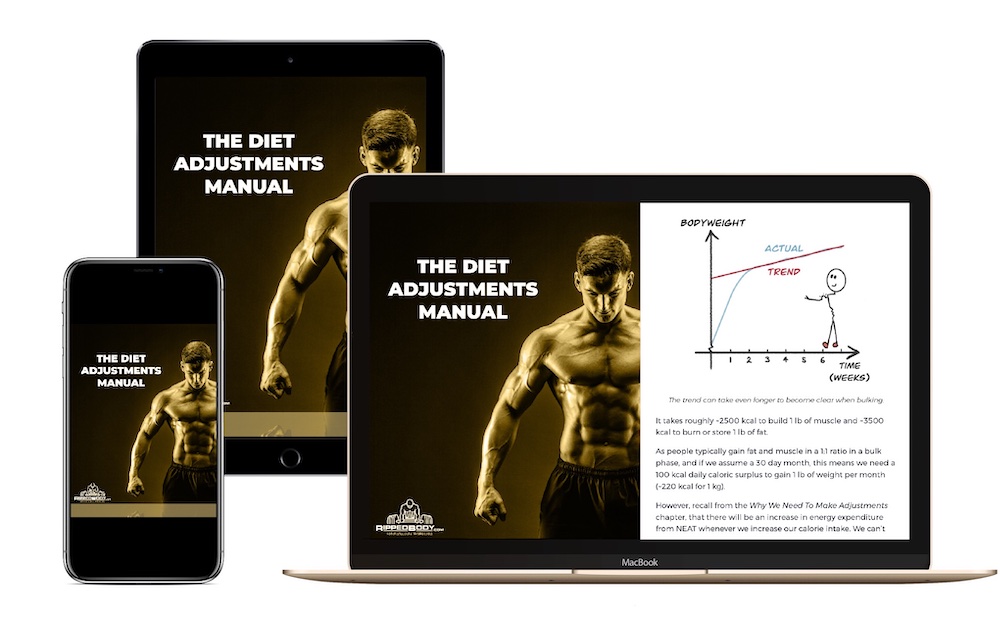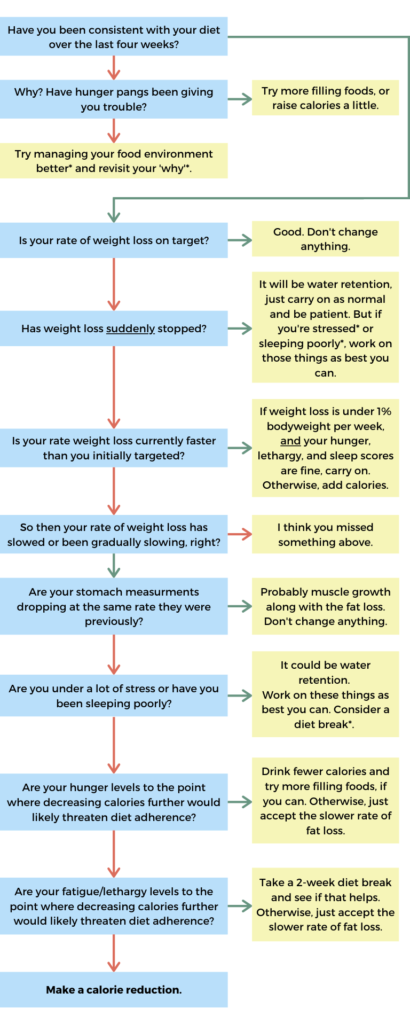You may have come to this article looking for guidance on the exact way to reduce carbs, fats, and protein when your diet stalls. But as someone whose job for the last decade has been coaching people online to get them shredded lean, I must tell you that making a reduction is the last thing I look to do.
There is no denying that the level of conditioning you can get to and sustain has a genetic component to it, but this guide will teach you how to get as lean as you possibly can.
There are two types of assessment and adjustment needed to be successful. The first involves assessing and correcting your initial calorie calculations.
The second type are the ongoing adjustments needed to keep progressing. I have split these guides into cutting and bulking phases. This article covers those when cutting (dieting).
👉 Related: How To Adjust Calories and Macros as You Bulk
Fat Loss Troubleshooting Checklist — My Decision-making Framework
When I coach people I don’t have a formal checklist that I go through. (I’ve been doing it so long that it’s all in my head.) However, this is how I tend to think about things. See below for explanations of each point.

Notes on the Cutting Adjustments Checklist
- You’ll notice that a calorie reduction is the last thing to consider. This keeps us eating as much as possible for as long as possible, which makes the diet more sustainable and minimizes our risk of muscle mass loss.
- If hunger pangs have been giving you trouble:
- Swap any liquid calories for whole food,
- Cut down on highly-palatable sugary foods,
- Eat more fruit and vegetables, salads and soups,
- Consider lowering meal frequency so that your meals are larger and more satisfying.
- To “manage your food environment” means to control things around you in such a way as to cause you to think about food a little less, reduce the number of temptations you face, and make it easier for you to make better choices throughout the day. It starts with appropriate food shopping and extends to how to organize things at home. This is a powerful tool that gets neglected by many dieters. I co-wrote an article on this with my friend Patrick Umphrey here.
- “Revisit your why” means to think more deeply about your motivations. Many people don’t pay enough attention to this part, and it means that when things get tough, they don’t follow through. I wrote an article sharing some of the exchanges with clients about this here.
- Stress is the silent killer of muscle mass. You can’t just say to yourself, “Ah, stress will cause water retention, but that’s ok, I’ll just be patient.” It will also impact recovery and thus your ability to hold onto muscle mass. Consider some strategies for managing stress. It is not my place to guide you on specifics, but I wrote my story of how I handled an incredibly stressful period in my life here.
- Poor sleep has a similar effect to stress. It will exacerbate hunger issues, and your training response will be dampened. It’s hard to say how much sleep is too little, but if you wake chronically tired, you need to get more. Here’s some advice for getting a better night’s sleep.
- We’re using bodyweight as the primary guide and not panicking if the body measurements don’t change much. Measurements can be prone to error and don’t always pick up the changes in the short term anyway. — More on what to expect from your measurements later in this chapter.
- If your average daily activity levels have decreased, you’ll probably need to make a reduction. However, I recommend you wait to see the effect on weight loss rate rather than proactively trying to adjust because the calorie burn estimations of most apps can’t be trusted. Many clients went through periods of lockdown in 2020. This barely affected some people’s energy needs but considerably altered others. If you have the step tracking feature turned on on your phone, you’ll be able to track your steps. Here’s how that looks:

From March to May 2020, you can see a dramatic reduction in my daily step count. Though I labeled it “first lockdown,” technically, there was never a lockdown in Japan, only “strong urges” from the government to stay home as much as possible. I took this to a bit of an extreme, not seeing anyone. I was eating the same but put on a little fat. Realizing how drastically my activity levels had been hit when I opened this app for the first time, I decided to go for more walks in the park.
In January of 2021, a tree rudely jumped out at me while I was snowboarding. I was on crutches for most of that month, which is why my activity levels plummeted.
The changes you will see when you diet won’t be as obvious. But it’s not uncommon to see a gradual decline in your step count due to increased lethargy (this is NEAT, discussed in the Why Calorie and Macro Adjustments Are Needed As We Diet chapter).
One way to counter this is to set yourself a minimum step target for the day when dieting. I set myself a daily minimum of 5000 steps from June onward, which was worse than the 7500 I was averaging prior to COVID but considerably better than the 2500 I was getting when left unmonitored.
When Should I Consider Adding in Cardio for Fat Loss?
There is no rule on when you should add in cardio to address calorie balance rather than decrease calorie intake further. But here’s how I think about it.
You may have come this far and wonder why I have not recommended cardio as an alternative to a calorie reduction. Mainly, it’s because cardio as a tool for fat loss is highly time-inefficient. The following charts will help explain what I mean.
As a reminder, we need a 500 kcal daily deficit to lose 1 of fat per week.

Let’s say you need an additional 200 kcal deficit, but you don’t want to eat any less. If you’re 180 lbs, this is 25 minutes of moderate-intensity cardio you need to do every single day to lose a mere 0.4 lbs extra each week.
This is not sustainable, and if taken to an extreme, can interfere with muscle and strength adaptations.
As a rule of thumb, your cardio for the week should be less than half the time you spend lifting weights. So, if you strength train for four hours per week, perform no more than two hours of cardio.
Preferably, choose a low-impact modality where your knees don’t take a pounding. Brisk walking on an incline treadmill, swimming, the elliptical, or cycling are preferable to jogging on a hard surface. This is especially true if you carry a lot of excess weight or have knee pain.
Preferably, avoid high-intensity interval training. The recovery needs are greater, and the injury risks are a little higher. As a reminder, if you do HIIT, you don’t get to choose the vigorous row for calorie burn. It’s high-intensity interval training, so you would choose the “moderate” row.
Lastly, bear in mind that adding cardio won’t necessarily help you with hunger issues. If you add in more exercise, your hunger will go up as a consequence also.
How to Adjust to Your Calories and Macros
Option 1: Repeat the calculation from the How To Assess and Correct Your Initial Calorie Calculations chapter.
This can give a sense of false precision, as there will be noise in the data from non-fat mass changes, so I prefer to do the following…
Option 2: Decrease overall energy intake by around 5-8%.
For most people, this is a 100–200 kcal reduction. Here’s the appropriate section from the table in the initial adjustments chapter.

Things You Will Notice As You Cut
The First Few Weeks
Your weight may drop much faster than you are targeting.
Don’t get excited; it is not all fat loss. This happens due to water, gut content, and glycogen losses. The more you drop your calorie and carb intake, the greater the drop. However, if your vegetable intake increases significantly, this will cause more gut residue and have an opposing effect.
Don’t be surprised if you have a relatively large and sudden decrease in the mid and lower-stomach measurements (1.5–2.5 cm, 0.5–1”). This is due to the lower gut content. It will be hard to see any trend in the stomach measurement data during the first weeks.
You may experience an increase in the chest and limb measurements if you have started a new training program. This will be due to muscle swelling (aka ‘the pump’), not muscle gain. If the thought, “OMG, my legs are growing so fast I’m not going to fit into any of my jeans at this rate!” crosses your mind, then you can relax. You’ve just started training your legs properly. This isn’t muscle growth. Fat loss will outstrip any muscle gain, and your legs will be smaller overall.
Hunger shouldn’t be an issue. You may even feel quite full if you have reduced your meal frequency and started to eat more vegetables. But don’t get complacent and think dieting is easy. Enjoy this while it lasts.
Energy levels throughout the day will mostly be unaffected. The diet hasn’t quite kicked in yet. Again, don’t get complacent.
You will probably continue to perform well in the gym. Glycogen stores aren’t yet depleted. Fatigue hasn’t had time to build up into a noticeable recovery deficit yet.
After the First Few Weeks
Your weight will continue to drop, but more slowly. This is because the decrease in weight is now caused by fat loss only. You’ll start to be able to estimate the rate of fat loss.
The drop in stomach measurements will become linear, and you will start to see a trend. As a rough guide, every 4–5 pounds of fat loss will show itself with a 2–2.5 cm (~1”) reduction on the stomach in two or more places.
In the 10–20% body-fat range, fat loss tends to happen from the upper abs first and works its way down. At the higher end of the range, you can expect to see more movement in the upper-stomach measurements than the lower; as you lean out, you’ll see more reduction from the measurements at the navel and lower.
At 10% body fat and below, you will see minimal change in the mid and upper-stomach measurements. The lower- stomach measurement and waist measurement will change the most because the fat on your very lower abs and back is coming off at this point. For this reason, visual changes will be hard to notice from the front, especially when getting leaner than 8% body fat when the fat on the abs is pretty much gone entirely.
Above 20% body fat, the measurements seem to drop fairly uniformly across all the stomach measurements. I assume this is because the majority of the fat loss at this point is visceral (the stuff around your organs) rather than subcutaneous (the fat under your skin).
You can expect there to be gradual decreases in the chest and limb measurements. Don’t take this to mean muscle loss. If you reach your right arm around and under your left armpit and grab your back at chest level, you’ll notice the fat immediately. It’s the same for many places on your body. Yes, fat is concentrated on the stomach, but we carry it everywhere.
You may feel that you look worse as you start to lose definition. This is natural; try not to get down about it.
There will be a gradual shift toward feeling hungry most of the time. Eating will become a pleasure, and foods will become tastier. This is your body trying to get you to eat more.
Those with a lot of fat to lose will see an improvement in their blood markers for disease risk.
You’ll start to feel happier with your appearance as you lean out. But you may start to feel small. (More on this in the next section.)
Toward the End of the Cut
You may be the least happy with your appearance. The point just before ab definition comes through is the hardest part of cutting. You’re tired, irritable, always hungry, and you will be your skinniest without the obvious reward. Push through. Bear in mind that nearly all the people you see on the results page are smaller overall, but leanness can make us look bigger when shirtless.
You may experience a loss in libido. Hormonal changes happen as the body winds down non-essential functions like reproduction. Dieting is managed starvation, and your body doesn’t know we are doing it purposefully and aren’t about to die due to a famine.
Hunger will be your constant companion. A celery stick will start to look delicious. Managing your food environment so that you don’t have easy access to tempting treats will be critical. Willpower alone can’t be relied upon.
Training will start to suck. Everything will be more challenging. You’ll be tempted to change things up, but don’t. The prolonged diet has taken its toll on your energy levels. You are (relatively) glycogen depleted. There is also a mechanical inefficiency of being leaner that will affect your big lifts.
How Much Hunger and Fatigue is Acceptable When Dieting?
HUNGER
As long as you can adhere, this is really up to you. The critical point here is adherence. You don’t want to get yourself in a binge–starve cycle, where the diet is so hard to adhere to that you end up binge eating. The most common pattern is where people are overly strict on the weekdays and throw it away on the weekends. If you find yourself unable to sustain things, increase your calorie intake and accept a slower rate of weight loss.
FATIGUE
As mentioned, your workouts may become considerably harder toward the end of a cut. If you struggle so much that your strength drops considerably, it may be best to increase your calorie intake and accept a slower weight loss rate.
How Do I Know if I Am Losing Muscle Mass?
This is a book about diet adjustments, not training. But as it is so important, there are a few things worth mentioning.
- Training is arguably the most important tool to prevent muscle loss when dieting; ensuring that we lose weight at a sensible rate is an inseparable part of this. Protein intake comes third to these two.
- You don’t have to change your training style when you cut, but you will find it harder to progress. At some point, that progress is likely to stop.
- On average, people progress during the first half of the cut and have to work hard to maintain their progress during the latter half. If they decide to get any leaner than 10% body fat, there will often be some regression. But these are just averages, and there are many different factors at play.
- Some lifts will progress better than others. Rarely are people equally experienced in all lifts. Expect good progress with any new (or unfamiliar) lift as you gain competency with your technique, but don’t take this to signify muscle growth. People coming back to training after time off can expect to make significant progress also.
- The bench press (and pushing exercises in general) tend to suffer the most, but that’s the combination of people generally having more experience here, as well as the loss of fat from the back and chest, meaning the bar has to travel further.
- The mind has a powerful effect on the body. Keep a positive mindset. Interestingly, some people tell themselves they won’t make any progress in a deficit, which becomes a self-fulfilling prophecy. The inverse can be true also.
- Stress and sleep issues will hamper how well you respond to training. Do your best to manage these things. Take these things into account when you assess your training.
- Lastly, different people are just different. I’ve seen some guys make progress throughout the entirety of a cut; I’ve seen some people get stuck earlier than I would expect.
Practically then, here is what I say to clients:
We’ll diligently implement the progression rules and take what progress we can, but we must accept that it will be harder to come by.
At some point, progress may stop in some lifts. When this happens, it is especially important to not get frustrated and let our form get sloppy cause this is when injuries happen.
Stick to the RPE guidelines. Work hard. Stay patient. The muscle gain is going to come in the bulking phase.
Yes, loss of strength can be a sign of muscle loss. But I can’t say I have seen this to any significant degree in my ten years of coaching. If we continue to train appropriately hard, lose weight at an appropriate rate, eat a sufficient amount of protein, and consume enough carbs to sustain your training, we don’t have to worry about muscle losses.

Thank you for reading. This was a sample chapter from my book, The Diet Adjustments Manual 📙.
Questions are welcomed in the comments and I answer daily.
How to Adjust Calories and Macros as You Diet FAQ
If your rate of weight change is not on target, you may need to adjust your macros. However, your weight will fluctuate within each day and across the week, so make sure you weigh yourself each morning, note the weekly averages, and compare across weeks.
1. If your diet adherence has been poor, you can’t fairly judge the efficacy of your current macros, so make sure you fix that first.
2. If your sleep quality is poor or you are under a lot of stress, for those issues first as they can cause water retention, masking fat loss.
Refer to the detailed checklist:
To adjust your macros to lose weight, for every 0.5 lbs, if you are short of your weekly weight loss target, subtract 250 calories from your daily food intake. Reduce carbs by 40 g, and fat by 10 g — more examples of this are in the table.
Protein should be set by body weight. 1 g per pound of body weight is a good target for most, but obese people are best to set protein intake by 1 g per centimeter of height.
I recommend that 15–25% of your calorie intake come from fats when cutting, and 20–30% when at maintenance or bulking. The rest should come from carbs. This means roughly 2/3 of your remaining calorie intake after accounting for protein, should be split toward carbs, with the rest to fats. More on the reasoning for this here: How To Set Your Macros for Fat Loss and Muscle Growth.
People who prefer more fat in their diet can take that higher, but I typically recommend no higher than 25% of calorie intake come from fat when dieting (30% when at maintenance or bulking), as this seems to be the sweet spot.
Though it is not my default recommendation, a few people seem to do well on higher-fat diets than this. See my article: How To Systematically Test If Keto Is Right For You.

Privacy policy.